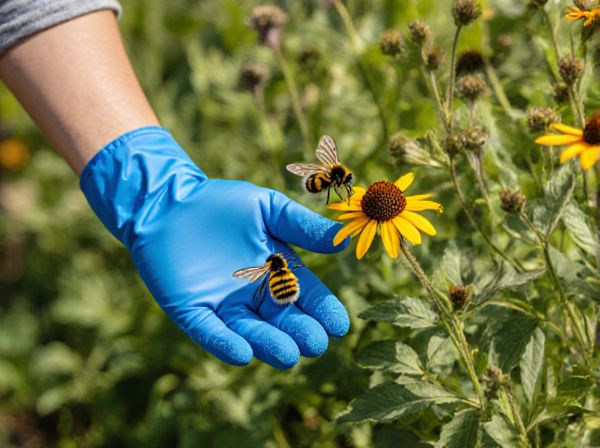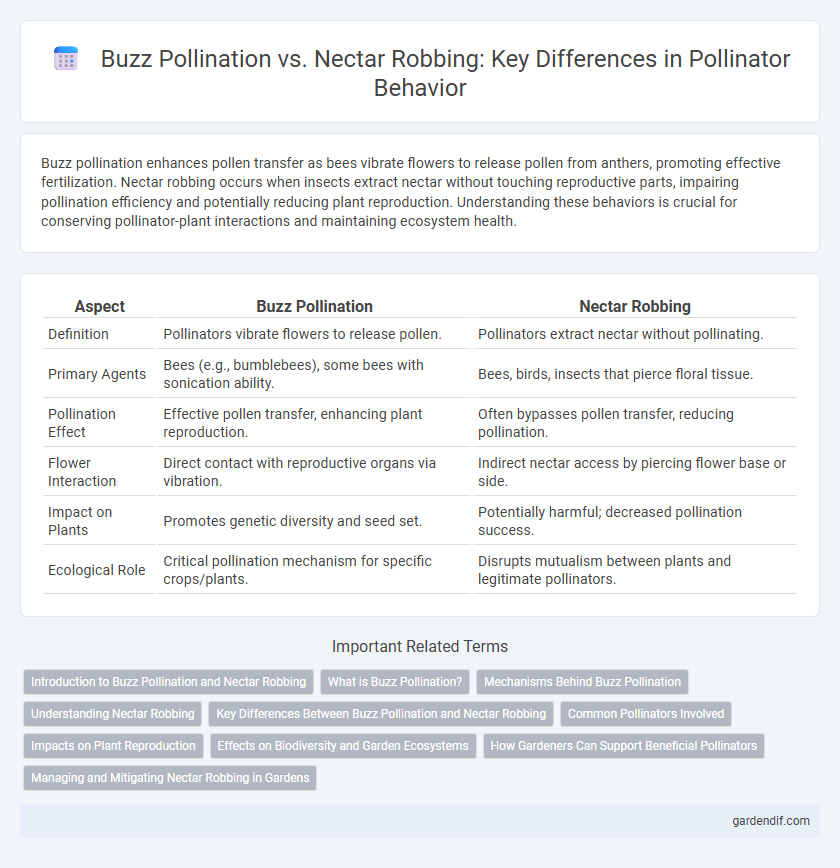
Buzz Pollination vs Nectar Robbing Illustration
Buzz pollination enhances pollen transfer as bees vibrate flowers to release pollen from anthers, promoting effective fertilization. Nectar robbing occurs when insects extract nectar without touching reproductive parts, impairing pollination efficiency and potentially reducing plant reproduction. Understanding these behaviors is crucial for conserving pollinator-plant interactions and maintaining ecosystem health.
Table of Comparison
| Aspect | Buzz Pollination | Nectar Robbing |
|---|---|---|
| Definition | Pollinators vibrate flowers to release pollen. | Pollinators extract nectar without pollinating. |
| Primary Agents | Bees (e.g., bumblebees), some bees with sonication ability. | Bees, birds, insects that pierce floral tissue. |
| Pollination Effect | Effective pollen transfer, enhancing plant reproduction. | Often bypasses pollen transfer, reducing pollination. |
| Flower Interaction | Direct contact with reproductive organs via vibration. | Indirect nectar access by piercing flower base or side. |
| Impact on Plants | Promotes genetic diversity and seed set. | Potentially harmful; decreased pollination success. |
| Ecological Role | Critical pollination mechanism for specific crops/plants. | Disrupts mutualism between plants and legitimate pollinators. |
Introduction to Buzz Pollination and Nectar Robbing
Buzz pollination is a specialized pollination mechanism where certain bees vibrate flowers to release pollen trapped in poricidal anthers, enhancing pollen transfer efficiency in crops like tomatoes and blueberries. Nectar robbing occurs when pollinators extract nectar without contacting reproductive flower parts, potentially reducing pollination success by evading pollen deposition. Understanding the contrasting roles of buzz pollination and nectar robbing provides insights into plant-pollinator interactions and their impact on agricultural productivity.
What is Buzz Pollination?
Buzz pollination is a specialized pollination mechanism where certain bees vibrate their flight muscles to shake pollen loose from flowers with poricidal anthers, such as tomatoes and blueberries. This vibration causes pollen to be expelled in a controlled manner, enhancing the efficiency of pollen transfer and improving fruit set in crops that require this technique. Unlike nectar robbing, which involves extracting nectar without pollinating the flower, buzz pollination directly facilitates pollination by actively releasing pollen.
Mechanisms Behind Buzz Pollination
Buzz pollination relies on vibration frequencies produced by certain bees, such as bumblebees, to release pollen from poricidal anthers that do not easily shed pollen through conventional means. This mechanism involves rapid muscle contractions in the bee's thorax that generate vibrations strong enough to dislodge pollen, enhancing pollination efficiency in plants like tomatoes, blueberries, and potatoes. In contrast, nectar robbing bypasses pollination by extracting nectar without contacting reproductive structures, often reducing the plant's reproductive success.
Understanding Nectar Robbing
Nectar robbing occurs when certain pollinators extract nectar from a flower without facilitating pollen transfer, often by piercing or biting through floral parts. This behavior can negatively impact plant reproduction by reducing nectar availability for legitimate pollinators, thereby decreasing effective pollination rates. Understanding nectar robbing involves recognizing its ecological consequences on plant-pollinator interactions and its role in reshaping floral traits and pollinator behavior.
Key Differences Between Buzz Pollination and Nectar Robbing
Buzz pollination involves bees vibrating flowers to release pollen from specialized anthers, enhancing pollination efficiency, particularly in crops like tomatoes and blueberries. Nectar robbing occurs when insects extract nectar without contacting reproductive parts, reducing pollination and potentially harming plant reproduction. The key difference lies in buzz pollination's active pollen transfer versus nectar robbing's passive nectar theft without pollination benefits.
Common Pollinators Involved
Buzz pollination primarily involves bees such as bumblebees (Bombus species) and carpenter bees (Xylocopa species), which vibrate flowers to release pollen. Nectar robbing is commonly carried out by species including certain bees like Xylocopa and some birds such as hummingbirds, which access nectar by piercing floral tissues. These behaviors significantly influence pollination efficiency and plant reproductive success.
Impacts on Plant Reproduction
Buzz pollination enhances pollen transfer by allowing bees to release pollen efficiently through vibration, significantly improving plant fertilization and seed production. Nectar robbing often reduces pollination efficiency by removing nectar without contacting reproductive organs, leading to lower pollen dispersal and diminished seed set. These contrasting behaviors critically influence plant reproductive success and population dynamics in ecosystems.
Effects on Biodiversity and Garden Ecosystems
Buzz pollination enhances biodiversity by enabling specialized pollen release from flowers like tomatoes and blueberries, promoting plant reproduction and ecosystem stability. Nectar robbing disrupts mutualistic relationships by extracting nectar without pollination, potentially reducing plant reproductive success and altering pollinator behavior. The contrasting impacts of buzz pollination and nectar robbing influence garden ecosystem health, affecting species diversity and the resilience of plant-pollinator networks.
How Gardeners Can Support Beneficial Pollinators
Gardeners can support beneficial pollinators by planting a diverse array of native flowering plants that encourage buzz pollination, a process where bees vibrate flowers to release pollen effectively. Avoiding pesticide use and providing natural habitats such as bee hotels or undisturbed soil fosters populations of buzz-pollinating bees. Minimizing nectar robbing by maintaining flower health and structure helps ensure pollinators access nectar properly, ultimately boosting crop yields and ecological balance.
Managing and Mitigating Nectar Robbing in Gardens
Managing nectar robbing in gardens involves using strategies such as planting diverse flower species that attract genuine pollinators like bees capable of buzz pollination, which efficiently releases pollen. Implementing physical barriers or using floral traits that deter robbers while promoting access for buzz-pollinating bees can reduce damage to flowers and increase pollination success. Monitoring pollinator behavior and encouraging natural predators of nectar robbers can further mitigate negative impacts on garden health and productivity.
Buzz Pollination vs Nectar Robbing Infographic

 gardendif.com
gardendif.com